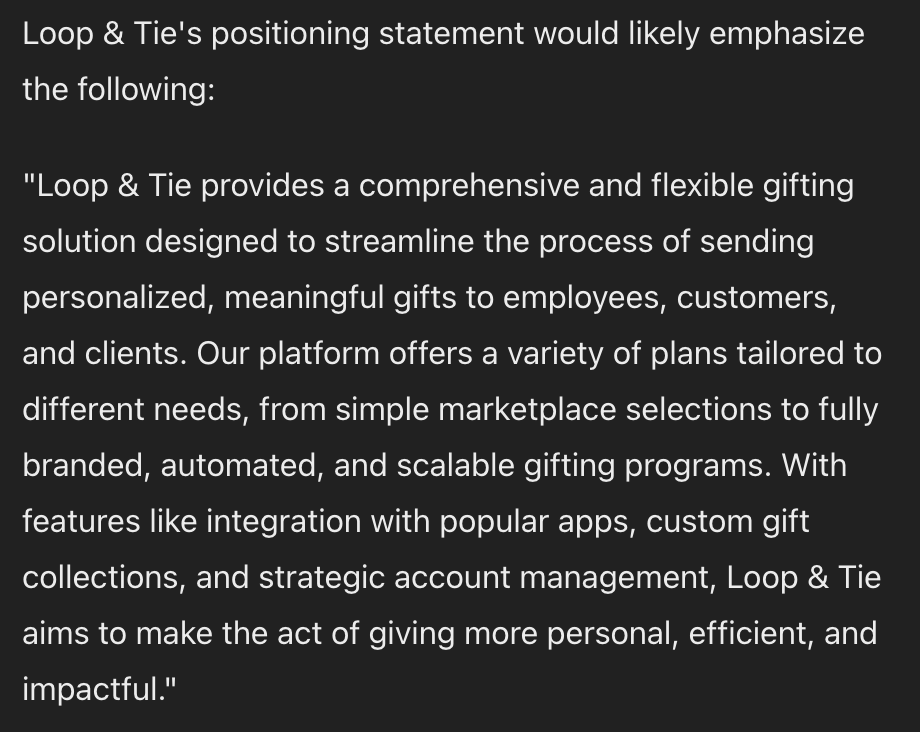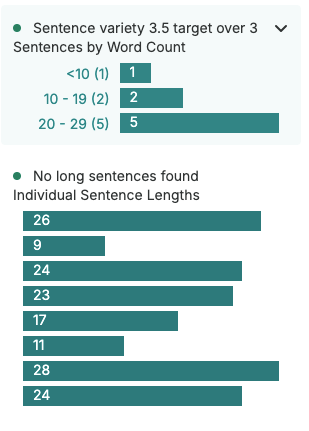Welcome back.
This week I want to take some time to break down a really cool brand I found called Loop & Tie, a corporate gift-giving platform.
I found Loop & Tie when looking for a gift for one of my own clients, and I was immediately intrigued. I think they’ve done an incredible job of showcasing their positioning through their brand voice, and I want to show you how.
Let’s dig in.
Who is Loop & Tie?
Loop & Tie is a corporate gift giving platform. They let you choose an amount that you want to spend on a gift, then they’ll send your recipient a link to a catalog of beautiful items they can choose from within that price range.
What’s cool about Loop & Tie is that the gifts your client can select are absolutely gorgeous. From thousand-dollar watches to quirky ceramics, most of the stuff seems to be really top-quality.
The company also makes a positive impact on the planet and for people. According to their LinkedIn profile, “Loop & Tie marketplace gifts are selected to bring corporate gifting budgets to small and artisan makers, women-owned businesses, BIPOC- and minority-owned businesses, and businesses making a direct positive impact on environmental sustainability issues.”
This is a stark contrast to many other corporate gifting platforms. If you’ve ever seen one of these things, you know what I’m talking about — you either get to choose a gift card (yaaaay), or you get to choose an item out of a sea of mass-produced garbage.
And that ☝️ is if you’re lucky. Sometimes you get shit that you never asked for. I once got a branded running shirt from a company. The quality was awful, and it was hideous. The giver then asked me to wear it during a marathon and take a photo so they could put it on their social media accounts.
So, it’s no wonder that according to Loop & Tie, 40% of corporate gifts end up in landfills. Most of these things are just garbage (literally) that we pick up at a conference or which gets sent to us for no reason.
Loop & Tie’s positioning
Loop & Tie appears to be working with a lot of different types of customers, from the LA Lakers to small businesses like mine. To give you an idea of the types of deals they’re doing, here’s a screenshot of their pricing table:

In some ways, this is a little confusing. The messaging is kind of hard to decipher at first, because the menu mentions things like platform features (which only larger companies would care about). When I asked ChatGPT to scan their website and write a positioning statement based on what it found, the results were accurate, but not totally differentiated.
I think going a bit narrower on the audience might help them create more targeted messages — but that’s honestly not what I want to focus on today.
Instead, I want to look at something they’re doing that’s really smart: creating a brand around identity, not just an audience segment.
Frankly, I don’t know if it matters to Loop & Tie that much if they’re working with someone from an enterprise or a small business like mine (though enterprise is likely more profitable).
What they care about is finding people who care deeply about quality gifts and reducing environmental impact. People like yours truly who don’t want to send garbage gimmicks around the world.
Here’s their current LinkedIn company description, which I think does an excellent job of explaining that value and getting someone on board behind it.
As a potential customer, Loop & Tie instantly connects with all of my personal and business values. It reinforces beliefs I have about myself and the world, which, in turn, creates an affinity for the company, even though I haven’t used their product.
That ^ is how you stick in someone’s head.
How it comes together in brand voice
Considering Loop & Tie’s core positioning is centered around their focus on high-quality craftsmanship, it’s no surprise that’s reflected in the brand.
I’m wholly unqualified to comment on a visual brand, but I will say that it definitely relates back to their core positioning around being modern, inclusive, and elevated. The colors are soft pastels, which is a bit quirky, but still inviting. They use inclusive imagery across the site. It’s assembled in a way that feels artisanal.
I looooooove their wordmark logo and the lowercase lettering. It feels refreshing. They’re using a typeface called Tiempos Text and I’m a little obsessed with it.
What I am qualified to talk about though (at least, as far as I know) is their voice. The reason I wrote this whole blog in the first place. I fell in love with it within a few seconds of landing on the website.
Vocabulary
Your brand’s vocabulary says a lot about you. And in the case of Loop & Tie, it tells us that this is a considered, measured personality that thinks deeply about what they do and how they show up in the world.
Look at the hero section on their home page, which has multiple multi-syllabic words like “differently,” “intentional,” and “experiences.” Notice that they also write out the word “three” instead of using the numeral.
They could have gone with the typical “B2B SaaS” voice of friendly and professional with a conversational tone. That would have sounded more like this:
See how that makes a difference?
Loop & Tie’s vocabulary is part of what makes their voice so distinctive. They tend to use open vowels that feel inviting and “softer” than hard consonants. They’re more likely to say “receive” than “get”, if that makes sense.
In fact, they probably use this longer language to encourage the reader to slooooooooow down and consider how special the gift-giving process could be if we invested a little more thought into it.
Tones
Tones are “what the dog hears” when you’re writing. It’s the emotion behind the actual words.
I break tones into a few different categories: primary tones, positive tones, and risk management tones.
I’d describe Loop & Tie’s primary tones as:
Thoughtful: Every gift in their marketplace is carefully selected, just like every word they use.
Intentional: Loop & Tie is your friend whose house is always clean, and who never buys anything frivolously. The company’s entire mission is to be conscious about our environmental and social impact. Their attitude reflects it.
Inclusive: Inclusivity is clearly a deep value of this company, and it echoes through in the way they approach things. They bring you into their mission and make you feel like you’re part of something.
Intimate: Not in a weird way. In a “come and drink tea and let’s talk about deep stuff” kind of way. Using words like “gift giver” and “gift recipient” are not only gender-neutral, they’re focused on the person. Other companies might substitute “recipient” with “audience” which would feel less personal.
Joyful: Loop & Tie appears to be a very gracious company. Their tones are optimistic without being giddy or over-the-top. They see a vision for a better world, and genuinely believe they can bring it to fruition.
When handling particularly positive experiences, Loop & Tie turns up the knob on that joyfulness. While they’re unlikely to use exclamation marks in most of their copy, they’ll use it to make an exciting announcement:
When dealing with more “negative” situations, Loop & Tie still remains positive, but moves more towards a sense of hopefulness. They tell you directly what they’re doing to solve the bigger problem:
Cadence
Cadence is the rhythm to somebody’s writing. The musicality of it.
I grabbed some samples of Loop & Tie’s copy to see how it plots out in ProWritingAid. I normally use a longer piece of text like a blog post for this. Their blogs seemed to have some AI influence to them (no shame), but I didn’t want to let AI influence the voice.
So, I copied a large part of the text from their “Why Loop & Tie” page and found this:
It’s worth noting that even though ProWritingAid says there aren’t any long sentences, we’re talking about web copy here. Web copy is usually as short as it can possibly be, so having a 28-word sentence is wild.
Loop & Tie doesn’t just write long sentences though. They also make them feel long with their vocabulary. Look at this sentence, which was the shortest one I analyzed:
Loop & Tie reduces financial and environmental waste through choice.
That’s nine words long — ten, if you include the “and” that you pronounce when you read the company name out loud — but because the words are multi-syllabic it takes a second to get through it.
You could take that same sentence and rewrite it to be way simpler, and it would feel shorter:
Loop & Tie cuts financial and environmental waste with choice.
I only changed two words — but it makes the sentence feel more direct.
Another example is this section. The sub-head has 22 words:
Here’s a (bad) re-write that changes the cadence (and therefore tone), without changing the word count.
So what can we learn from this?
Honestly, I think there’s a lot. But two things stand out to me:
First, the biggest takeaway that I’ve gotten from this analysis though is that if you want to create an effective, sticky brand, the key is to appeal to your audience’s value systems. Loop & Tie has done a masterful job at this. The brand reflects something honest and true about their business that makes it feel charismatic. When it gets put in front of the right audience, there’s a magnetic attraction.
Second, Loop & Tie is a great example of a company that has personality, but which isn’t in-your-face with their execution of it. They’re not overly enthusiastic or antagonistic, and their voice doesn’t punch you in the face as soon as you land on the site. Instead, what they’ve done is craft an emotive experience that directly reflects the deeper value of their offer: carefully selected gifts that your recipient will cherish.
Both of these elements demonstrate a really solid foundational understanding of what the company actually stands for, and their willingness to commit to it.
It’s really, really hard to do. And I’m amazed at their ability to make it happen.
Thanks for reading
If you’ve made it this far, I really massively appreciate your time spent here.
If you liked the post, it would be a huge help if you shared it on LinkedIn or restacked it on Substack. That’s the easiest way to get more people to see my work (and I’ll love you forever).
If you’re here and haven’t subscribed, feel free to add yourself to the list below (though no pressure — I understand your inbox is holy ground). Every Friday I send an email with some thoughts on the current state of B2B marketing, links to interesting podcasts, and a brand voice breakdown.


















